By Mike Markowitz for CoinWeek …..
In recent years, Heritage Auctions has become a major player in the ancient coin market. Traditionally in America, the most important ancient coin auctions of the year take place in January, in association with the New York International Numismatic Convention (NYINC).
This year is no exception, even though the show itself has been canceled.
Heritage Auction #3809, closing on January 21 and 22, 2021 in Dallas, offers a spectacular array of rare and beautiful ancients. Many of these come from the “Penn Collection”, evidently assembled by a wealthy connoisseur in the 1980s and ’90s. This article examines some highlights of the upcoming auction.
Ionian Revolt Electrum Stater
In 499 BCE, 12 Greek cities of Ionia[1] on the eastern shore of the Aegean Sea rose in revolt against the Persian Empire of Darius the Great (ruled 522-486 BCE). The rebellion was brutally crushed, leaving a lasting legacy of bitterness between Greeks and Persians.

One of the earliest coins in the sale is Lot 31029, an electrum stater of 14 grams from this period. Electrum is an alloy combining gold and silver in variable proportions, and a stater is an ancient Greek weight unit that ranged from about seven to 17 grams, depending on the local standard. Since this coin is based on the “Milesian” weight standard of Miletus, it was probably struck there. The coin bears the head of a roaring lion wearing a beaded collar. The reverse is just an irregular punch mark. In 1997, this coin sold for $11,500[2].
Syracuse 16 Litrai
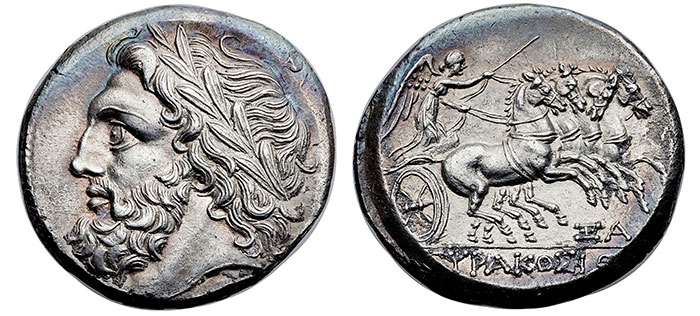
The proud Greek city of Syracuse near the southeastern tip of Sicily had a turbulent history, with a long succession of tyrants interrupted by brief episodes of democratic governance.
In 215 BCE, the last tyrant, Hieronymos, just 15 years old, inherited the throne of his grandfather, Hiero II, who had ruled for more than five decades of peace and prosperity. Young Hieronymos made a fateful and unwise decision to ally with Carthage in its war against Rome. After just 13 months of rule, Hieronymos was assassinated and the “Fifth Democracy” was established.
Under a ferocious Roman siege for the next three years, the city still maintained its long tradition of beautiful coinage.
Lot 31014 represents the last spectacular flowering of Syracusan coinage, a rare silver piece of 16 litrai (a litra was equal to one-fifth of a drachma, or 0.87 gram). About 14 examples are known. The obverse is a majestic laurel-wreathed head of Zeus. On the reverse, Nike drives a chariot pulled by four spirited, prancing horses above the simple inscription ΣYPAKOΣΙΩΝ (“of the Syracusans”) A “good extremely fine” example of this type realized over $76,000 in a 2016 Swiss auction[3].
In 212 BCE the Romans finally sacked Syracuse, killing the famous scientist Archimedes.
Pyrrhus Stater
In 280 BCE, King Pyrrhus of Epirus, in northwestern Greece was invited to intervene in a war against Rome waged by the port city of Tarentum in southern Italy. Hoping to emulate the conquests of his kinsman and role model Alexander the Great, Pyrrhus fought bloody, indecisive battles against the Romans until he concluded “If we are victorious in one more battle with the Romans, we shall be utterly ruined.” This is the origin of the phrase “Pyrrhic victory”.
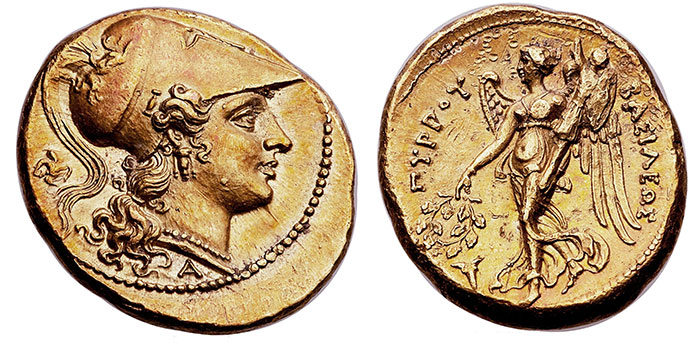
To finance his wars, Pyrrhus issued magnificent gold staters, c. 278-276 BCE, at Syracuse, a Sicilian city with a long tradition of beautiful coinage. Lot 31012 is graded “Choice, About Uncirculated, Fine Style”. The obverse shows the helmeted head of the goddess Athena, while the reverse features an elegantly draped Nike seeming to float above the ground holding a trophy of arms and a wreath of oak leaves. An exceptional example of this coin, better centered, brought $180,000, against an estimate of $40,000, in a 2012 New York auction[4].
Ptolemy Trichryson
The riches of Egypt’s ancient rulers were legendary, and the dynasty of the Ptolemies, who ruled at Alexandria from 305 to 31 BCE, issued some of the heaviest gold coins struck in antiquity. Lot 31036 is a rare gold trichryson (“triple gold piece”) or pentadrachm (“five drachma piece”) of Ptolemy II, who ruled from 285 to 246 BCE. The obverse bears the portrait of his father, the dynastic founder Ptolemy I. The reverse shows a majestic eagle grasping a thunderbolt in his talons, with the Greek inscription ΠTOΛEMAIOY-BAΣIΛEΩΣ (“of king Ptolemy”).

Weighing almost 18 grams, the coin would have been valued – in the words of the cataloguer – at:
60 silver drachms – a huge sum in the ancient world. It was the largest gold coin the world had yet seen, testament to the vast wealth of Egypt.
In its last appearance at auction in 1997, this coin realized $5,000 against an estimate of $6,500[5]. Only two other examples of this coin have appeared on the market in recent years.
Arsinoe Mnaieion

An even heavier Ptolemaic gold coin, Lot 31044, was issued by an uncertain ruler (Ptolemy VI, VII or VIII) sometime after 193 BCE. It honors the memory of Arsinoe II, wife and sister of Ptolemy II “Philadelphus”. She was declared a goddess after her death (c. 270 BCE). The Greek epithet Philadelphos means “sibling loving”, as in the name of Philadelphia, the “City of Brotherly Love”. The massive coin weighing almost 28 grams, has two names: octodrachm (“eight drachma piece”) based on its weight, and mnaion (or mnaieion) based on its equivalent value, one mina (100 drachms) of silver.
The obverse is a portrait of the queen. The reverse shows a symbol of prosperity, a double cornucopia (“horn of plenty”) tied with ribbons and filled with cakes and fruit. A similar, but scuffed, coin in a recent Heritage auction brought $22,000[6]. This coin is graded “Choice MS”, and appears flawless. The gold octodrachm of Arsinoë II is #74 in Harlan J. Berk’s 100 Greatest Ancient Coins (Berk 2019, xx).
Berenike Pentakaidekadrachm
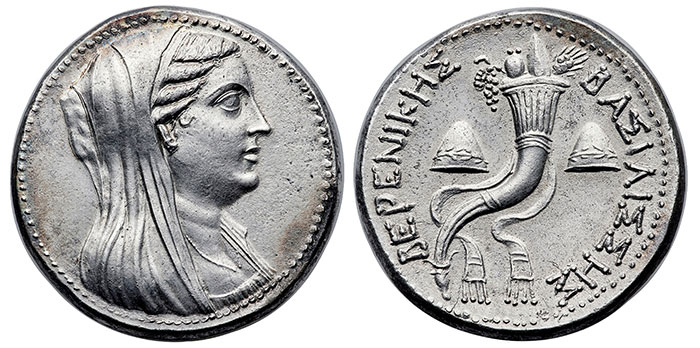
Since Egypt had no silver mines, silver was a highly prized import. Lot 31041 is one of the largest silver coins struck in antiquity, 42 mm in diameter weighing over 52 grams. It was an ostentatious tribute to Berenice II (or Berenike), wife of Ptolemy III, who ruled from 246 to 222 BCE.
The cataloguer writes:
One of the most formidable Ptolemaic queens, Berenice II’s family background was unusually convoluted and bloody, even by Macedonian standards. Born in 267 BC, she was the daughter of the Cyrenaican king Magas and his wife Apama. In 249 BC, upon the death of Magas, her mother married her off to Demetrius the Fair, son of Demetrius Poliorcetes, who was invited to become king of Cyrenaica. Demetrius, however, was more interested in Apama than her daughter, and, catching him in her mother’s bed, Berenice stabbed him to death. Despite this, her legendary beauty prompted Ptolemy III of Egypt to marry her, in 244/3 BC, and the duo became the foremost “power couple” in the world.
The name of the denomination is a tongue-twister: pentakaidekadrachm, literally “five and ten drachma piece” based on its weight. A similar coin, but with a flan crack, realized over $50,000 in a 2017 auction[7]. On Berk’s list of the 100 Greatest Ancient Coins, this type is #58 (Berk, 72). About 40 examples are known, some of them broken.
Demetrius Tetradrachm

Know as Demetrius Poliorcetes (“the Besieger”) for his epic unsuccessful siege of the great fortress city of Rhodes, Demetrius I ruled the kingdom of Macedon from 306 to 283 BCE. Lot 31021, a Mint State silver tetradrachm, celebrates his naval victory over the Ptolemaic fleet off Salamis on the island of Cyprus in 306 BCE[8]. The obverse shows the winged figure of Nike standing on the prow of a warship, blowing a trumpet. On the reverse, the naked muscular figure of Poseidon, god of the sea, extends his left arm draped with his cloak, about to hurl his trident. The inscription, BAΣIΛEΩΣ ΔHMHTPIOY, simply states “of king Demetrius”.
While the coin is not particularly rare, examples of this quality are scarce, and typically sell for over $4,000. On Berk’s list of the 100 Greatest Ancient Coins, this type is #56 (Berk, 67).
Philip II Aureus
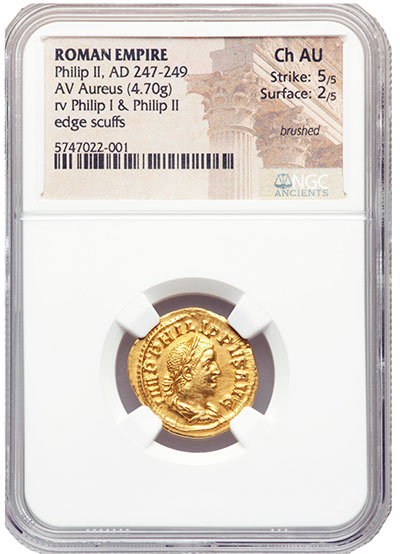 Philip II (ruled 359 – 336 BCE), king of Macedon and father of Alexander the Great, is familiar to most ancient coin collectors, but Philip II (ruled 247-249 CE) boy-emperor and son of Philip I “the Arab” is a nearly unknown figure from a chaotic period of Roman history. Lot 31066 is a rare gold aureus of this short-lived emperor, who was murdered by the Praetorian Guard at the age of 12.
Philip II (ruled 359 – 336 BCE), king of Macedon and father of Alexander the Great, is familiar to most ancient coin collectors, but Philip II (ruled 247-249 CE) boy-emperor and son of Philip I “the Arab” is a nearly unknown figure from a chaotic period of Roman history. Lot 31066 is a rare gold aureus of this short-lived emperor, who was murdered by the Praetorian Guard at the age of 12.
Gold coinage from this era is very scarce, and the weight of the gold aureus, which had long been standardized at 50 to the Roman pound (6.5 grams), fell sharply. This coin weighs just 4.7 grams. The obverse bears an exceptionally lifelike portrait of the young ruler; on the reverse, he appears seated beside his father with the inscription LIBERALITAS AUGG III (“Generosity of the Emperors, for the Third Time”).
This commemorates a distribution of money to the population, presumably for the celebration of the thousandth anniversary of the founding of Rome. When this coin was last sold in a 2018 Swiss auction, it brought over $41,000[9].
Crispus Solidus
Crispus was the eldest son of Constantine the Great[10]. Born about 295 (the date is uncertain) he was raised to the rank of “Caesar” – in effect, heir apparent – in 317. CRISPUS CAESAR is the title that appears on the coins issued in his name.
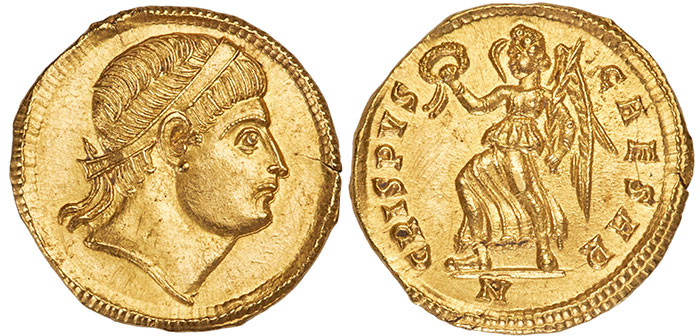
Lot 31070 is a gold solidus struck at the imperial capital of Nicomedia (now Izmit, Turkey). His portrait appears without inscription on the obverse, with the upward gaze that modern numismatists describe as “Eyes to God”. The reverse shows the winged female figure of Victory, bearing a wreath and palm branch.
In 326, Crispus was accused of adultery by his step-mother Fausta and executed on the orders of his father. When Constantine determined that her accusation was false (perhaps because Fausta wanted to secure succession to the throne for her own sons), Fausta was executed in an overheated steam bath. When this coin was last sold in a 2007 Swiss auction, it brought over $26,000[11].
Theodosius Solidus

Emperor Maurice Tiberius (Mavrikios Tiberios) who ruled in Constantinople from 582 to 602 CE, had a son named Theodosius[12], born about 583, who was crowned co-emperor as a child. In 597 or 598, the mint of Carthage in North Africa struck coins in the boy co-emperor’s name.
Just three examples of the gold solidus are known: “one stolen, possibly melted, another never seen, the last and possibly unique, here (Berk).” This coin, Lot 31079, one of the greatest Byzantine rarities, last appeared in 1998 in Sotheby’s New York sale, with an estimate of $40,000 – 50,000.
Michael IV Histamenon
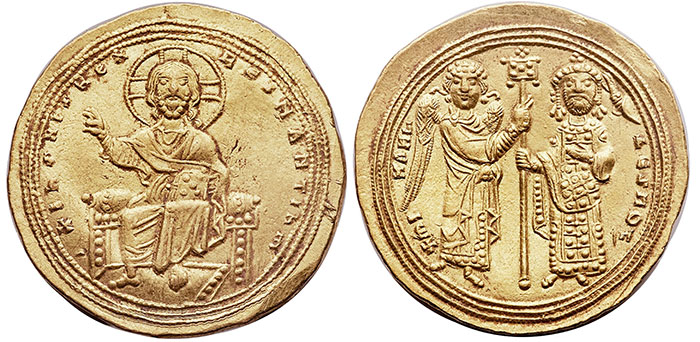
Lot 31081 is a very rare gold histamenon considered by some collectors to be the most beautiful of all Byzantine coins. Less than 15 examples are known. The coin is attributed to either Michael IV “the Paphlagonian” (ruled 1034-1041) or Michael V “Calaphates” (ruled December 21, 1041 to April 13, 1042). Numbering rulers with the same name did not become a regular practice until the 17th century.
On the obverse, Christ sits enthroned, His hand raised in a gesture of blessing. On the reverse, the winged Archangel Michael hands a standard to his namesake, the emperor, the two standing figures staring out at the viewer. In a 2015 London auction, an example of this type brought over $27,000[13].
On Berk’s list of the 100 Greatest Ancient Coins, this type is #100 (Berk, 125).
Mezezius Solidus
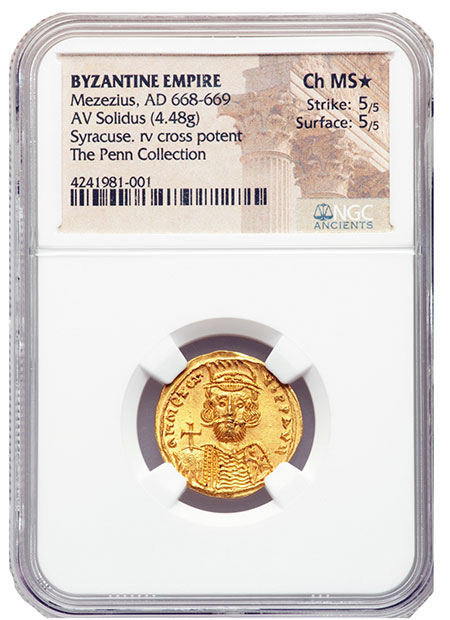 A great rarity, with about seven examples known, Lot 31080 is the finest known gold solidus issued by Mezezius (Mizizios or Mzhezh), an Armenian general who briefly seized the throne following the murder of Emperor Constans II in his bath at Syracuse in Sicily (September 15, 668). After a few months, the rebellion was suppressed by Constantine IV, son of Constans II, and Mezezius was executed.
A great rarity, with about seven examples known, Lot 31080 is the finest known gold solidus issued by Mezezius (Mizizios or Mzhezh), an Armenian general who briefly seized the throne following the murder of Emperor Constans II in his bath at Syracuse in Sicily (September 15, 668). After a few months, the rebellion was suppressed by Constantine IV, son of Constans II, and Mezezius was executed.
The coin is boldly but crudely engraved – the second “Z” in the name of Mezezius is backward! On the obverse, the usurper wears a plumed helmet, and an elaborate breastplate with a small cavalry shield hung on the left shoulder. His right hand grasps the globus cruciger – an orb topped with a cross that was one of the imperial regalia. The reverse bears a cross on three steps surrounded by the standard Latin formula VICTORIA AUGU… (“Victory of the Emperor”). This coin last appeared in a 1998 New York auction, with an estimate of $50 – 70,000[14].
* * *
Notes
[1] These included the city-states of Miletus, Myus, Priene, Ephesus, Colophon, Lebedos, Teos, Clazomenae,Phocaea, Erythrae,and the islands of Chios and Samos.
[2] CNG Auction 42, May 29 1997, Lot 475. Realized $11,500 USD.
[3] NAC Auction 72, October 6, 2013, Lot 1032. Realized CHF 75,000 (about $76,538 USD; estimate CHF 35,000).
[4] New York Sale XXVII, The Prospero Collection, January 4, 2012, Lot 342. Realized $180,000 USD (estimate $40,00).
[5] Triton I sale, December 2, 1997. Realized $5,000 USD (estimate $6,500).
[6] Heritage Sale 3088, November 5, 2020, Lot 33016. Realized $22,000 USD.
[7] Hess-Divo Auction 333, November 30, 2017, Lot 58. Realized CHF 50,000 (about $50,916 USD; estimate CHF 25,000).
[8] https://en.wikipedia.org/wiki/Battle_of_Salamis_(306_BC)
[9] NAC Auction 111, September 24, 2018, Lot 198. Realized CHF 40,000 (about $41,654 USD; estimate CHF 35,000).
[10] https://en.wikipedia.org/wiki/Crispus
[11] NAC Auction 40, May 16 2007, Lot 857. Realized CHF 32,000 (about $26,266 USD; estimate CHF 15,000).
[12] https://en.wikipedia.org/wiki/Theodosius_(son_of_Maurice)
[13] Roma Numismatics, Auction 10, September 27, 2015, Lot 939. Realized £18,000 (about $27,314 USD; estimate £20,000).
[14] Sotheby’s (1998) Lot 286.
References
Berk, Harlan J. 100 Greatest Ancient Coins, 2nd edition. Whitman: Pelham, AL (2019)
–. Roman Gold Coins of the Medieval World, 383-1453 AD. Joliet, IL (1986)
Melville Jones, John. A Dictionary of Greek Coins. London (1986)
Sotheby’s. An Important Private Collection of Byzantine Coins. New York (1998)




